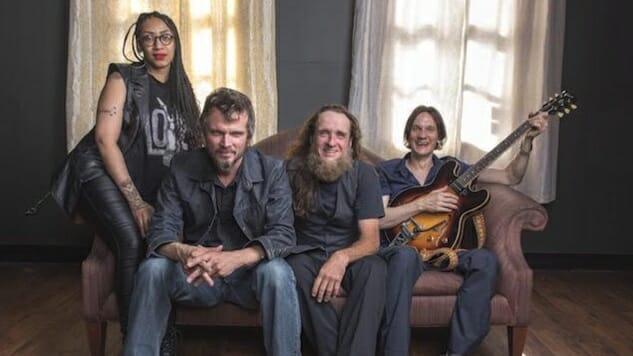The Curmudgeon: New and Old Masters of the Mississippi Blues
Photo by Wyatt McSpadden, courtesy of New West Records
The North Mississippi Allstars (from left: Sharde Thomas, Luther Dickinson, Carl Dufresne and Cody Dickinson)
Driving through northern Mississippi, one is immediately struck by how empty and how poor the area is. One can drive for miles along the state highways and see only a handful of small houses and farms amid the tall walls of pine trees. And yet from this underpopulated, underemployed corner of the American South came a version of the blues that sparked much of the nation’s most original music. And recent albums from the North Mississippi Allstars and Jimmy “Duck” Holmes proves this music is still throwing off sparks today.
The blues popped up everywhere in the South that enslaved Africans and their descendants gathered in any numbers. But nowhere did the blues remain as close to its old-world origins—to the sounds that one can still hear in rural West Africa—as it did in North Mississippi. Because segregation was so profound in this region, the African character of the music was less changed and survives in a purer state.
When we say this form of the blues is more African, we mean it makes fewer concessions to European harmony and less compromises with American sentimentality. This music rarely uses the I-IV-V pattern of the blues, because it believes three chords are one too many. The North Mississippi blues taps into something elemental from a time before African and European music made contact.
This music’s muscular rhythmic drive is restrained by its lack of chordal movement, and the resulting tension mirrors the conflict at the heart of human nature: the immensity of desire and the equal enormity of frustration. The isometric strain of these colliding forces creates the most powerful push-and-pull in music. That taut pressure becomes all the more disorienting when the musicians throw time signatures and bar lines out the window, allowing the downbeat to fall wherever it feels good.
The Mississippi Delta gets all the publicity, but the best examples of this phenomenon can be found just northeast of the Delta in the Mississippi Hill Country and just southeast of the Delta in Yazoo County. These areas were too hilly and too unproductive for the kind of giant plantations established on the Delta flatlands, so the small farms owned and/or worked by black families were ignored and allowed to practice their own culture.
In the early 1960s, when folklorists began visiting these areas in search of overlooked gems, they found Skip James in Yazoo County’s Bentonia, singing in a haunting falsetto and playing guitar in an open E-minor tuning in an eerie echo of African griots as filtered through Bahamian islanders.
They found Mississippi Fred McDowell and his protégé R.L. Burnside playing push-and-pull one-chord vamps surprisingly similar to the Malian kora players discovered a little later. Most astonishing of all, they found Othar “Otha” Turner cutting sugar-cane stalks into wind instruments and using them as the basis for call-and-response fife-and-drum bands that echoed African village ceremonies.
Listen to “Mississippi” Fred McDowell perform at the Newport Folk Festival:
The North Mississippi Allstars’ terrific new album, Up and Rolling, features singer/guitarist Luther Dickinson, who apprenticed himself to Turner and Burnside at the beginning of his career, and singer/percussionist Cody Dickinson—Luther’s brother, co-producer and longtime bandmate. Their father was legendary Memphis blues-rocker Jim Dickinson, who moved his family to a farm in Woodville, Miss., to get closer to the music’s roots.
Contributing to the album’s impact are Sharde Thomas (Turner’s granddaughter and current Allstar), Cedric Burnside (R.L.’s grandson and his longtime drummer), Garry Burnside (R.L.’s son and Junior Kimbrough’s bassist), Duane Betts (Dickie Betts’ son), Mavis Staples (daughter of North Mississippi guitarist Roebuck “Pops” Staples), Charles Hodges (the Hi Rhythm Section’s keyboardist) and Jason Isbell (north Alabama guitarist).
-

-

-

-

-

-

-

-

-

-

-

-

-

-

-

-

-

-

-

-

-

-

-

-

-

-

-

-

-

-

-

-

-

-

-

-

-

-

-

-








































